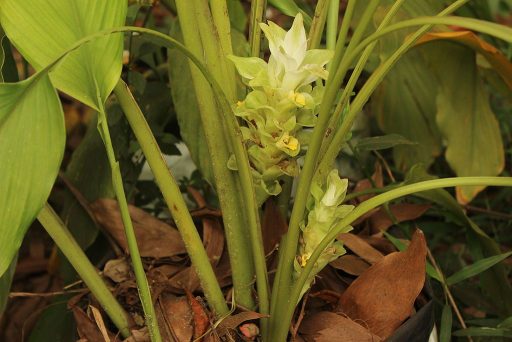Turmeric
Curcuma longa
Family: Zingiberales | Place of Origin: Southeast Asia
Origins and history:
Turmeric has been cultivated since ancient civilizations in India and later in China. Over time, it spread through trade routes to the Middle East, Africa (especially becoming a staple in Ethiopian cuisine), and Europe. Today, turmeric is grown in India, China, Myanmar, Nigeria, and Bangladesh. Many countries around the world (including the US) are major importers of turmeric. This plant holds economic value as a culinary spice, dye, medicine, and coloring agent. It is culturally significant in India and China where it is a staple in their traditional cuisine and medicine, and has been established in Ethiopia as well.

Identification characteristics
- General: Turmeric is a perennial, herbaceous plant that grows up to 3ft tall.
- Leaf morphology: The leaves of turmeric are broad, oblong, bright green, and have prominent parallel veins. They have sheaths near the base of the leaf before it attaches to the stem. The leaves are alternately arranged.
- Floral morphology: Turmeric flowers have large, bright pink-to-purple petals on top of a long flower stalk.
- Root: Turmeric has very shallow rhizomes that are thick, fleshy, and tan colored with darker brown stripes. If these structures are cut open they are bright orange and have a distinctive earthy smell. These roots are what turmeric is often known and used for.
Uses and preparation
The rhizomes of this plant are boiled and dried to form a light, airy, bright yellow powder that can be used as a spice in cooking. Rhizomes can also be eaten raw or grated in small quantities. Turmeric in this form is also a major ingredient in curry powder. Turmeric is also used as a coloring agent in manufactured products and has historically and culturally been used as a dye for clothing in Indian culture. This plant has historically been used for diverse medicinal uses although little rigorous scientific testing has been done on turmeric’s medicinal properties in modern times. Major components of this plant, most especially curcumin (a component of the rhizome that gives it its yellow color and many medicinal properties). Turmeric and curcumin has been used as a cure for inflammation, arthritis, depression, liver disease, digestive stimulant, allergies, skin conditions, and anti-cancer tumors. This plant also has natural antimicrobial and antifungal properties. Although little rigorous scientific studies have been done on the safety of turmeric as a medicine, it has been consumed and used in these ways for millennia by many different cultures.